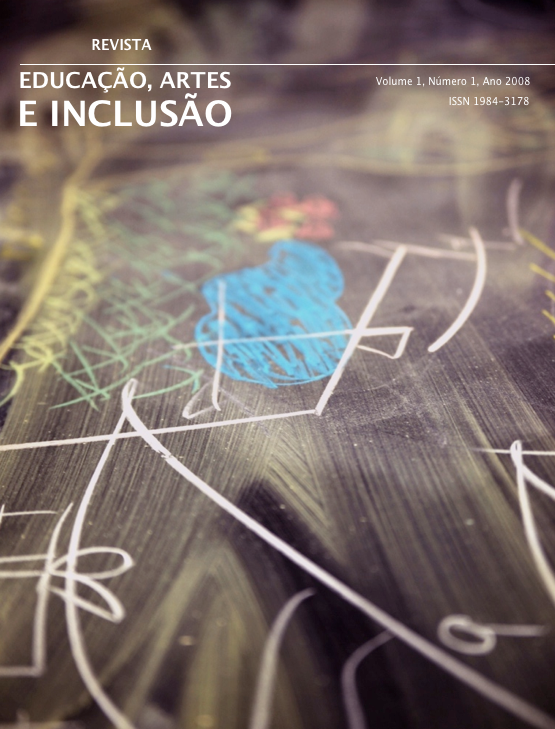ARTES VISUAIS E INCLUSÃO: O SIMBOLISMO NA EXPRESSÃO DE CRIANÇAS E ADOLESCENTES COM NECESSIDADES EDUCACIONAIS ESPECIAIS
Abstract
Este estudo é o resultado de uma pesquisa intitulada “O Simbolismo na Expressão de crianças com Necessidades Especiais”, realizada no Grupo de Estudos e Pesquisas em Educação e Artes Visuais - GEPEAV/CNPq. É um trabalho de investigação teórico-prático com materiais potencialmente plásticos, junto a pessoas com necessidades educacionais especiais. Busca-se promover, por meio do estímulo da expressão estética da criança, uma experimentação artística e suas possibilidades criativas, afetivas, motoras e intelectuais. As atividades foram desenvolvidas através de experiências e representações criativas com vivências artísticas, e posterior análise, reflexão e interpretação dos percursos de duas crianças e suas produções em uma Escola Especial. Objetiva-se investigar a promoção da inclusão da arte no desenvolvimento da criatividade das pessoas com necessidades educacionais especiais, a fim de estimular a busca de seus próprios meios de expressão com referência nos seus elementos pessoais intersubjetivos. Acredita-se na importância do incentivo à espontaneidade, descoberta de capacidades e auto-valorização ao longo do processo da inclusão da arte.
Palavras-Chave: Artes Visuais, Inclusão, Simbolismo e Expressão
Abstract: Visual arts and inclusion: Symbolism in the expressions of children and adolescents with special needs. Current analysis hailed from a research entitled ‘Symbolism in the expressions of children and adolescents with special needs,’ undertaken by the Group for the Study and Research in Education and the Visual Arts (GEPEAV/CNPq). The theoretical and practical investigation comprises potentially plastic material used by people with special needs. Artistic experimentation and its creative, affective, motor and intellectual possibilities are highlighted by the stimulus in the child’s aesthetic expression. Activities were developed through experiences and creative representations with artistic modes, coupled to analysis, reflection and interpretation of two children’s trajectory and their production in a Special School. Art inclusion in the development of creativity of people with special education needs was investigated so that the search for autonomous expression could be found with reference to their intersubjective personal elements. Results show the importance of the stimulus to spontaneity, the discovery of abilities and self-valorization throughout the inclusion process of art.
Key-Words: Visual Arts; Inclusion; Symbolism; Expression.
Downloads
Downloads
Published
How to Cite
Issue
Section
License
Copyright Statement
The Educação, Artes e Inclusão is a journal that follows the Free Access Policy. The articles published by the journal are free of charge, intended for educational and non-commercial applications. The articles whose authors are identified represent the expression from the point of view of their authors and not the official position of the Educação, Artes e Inclusão Journal or the Educação, Artes e Inclusão Research Group.
Authors who publish in this journal agree to the following terms:
(A) Authors retain the copyright and grant the journal the right of first publication, with the work simultaneously licensed under the Creative Commons Attribution License which allows the sharing of the work with acknowledgment of authorship and initial publication in this magazine.
(B) Authors are authorized to take additional contracts separately, for non-exclusive distribution of the version of the work published in this journal (eg publish in institutional repository or as a book chapter), with acknowledgment of authorship and initial publication in this magazine.
(C) This journal provides public access to all of its content, as this allows for greater visibility and scope of published articles and reviews. For more information on this approach, visit the Public Knowledge Project.
This journal is licensed under a Creative Commons Attribution-NonCommercial-ShareAlike 4.0 International License. This license allows others to remix, adapt and create from your work for non-commercial purposes, and although new work must give you due credit and cannot be used for business purposes, users do not have to license such derivative works under the same terms.



